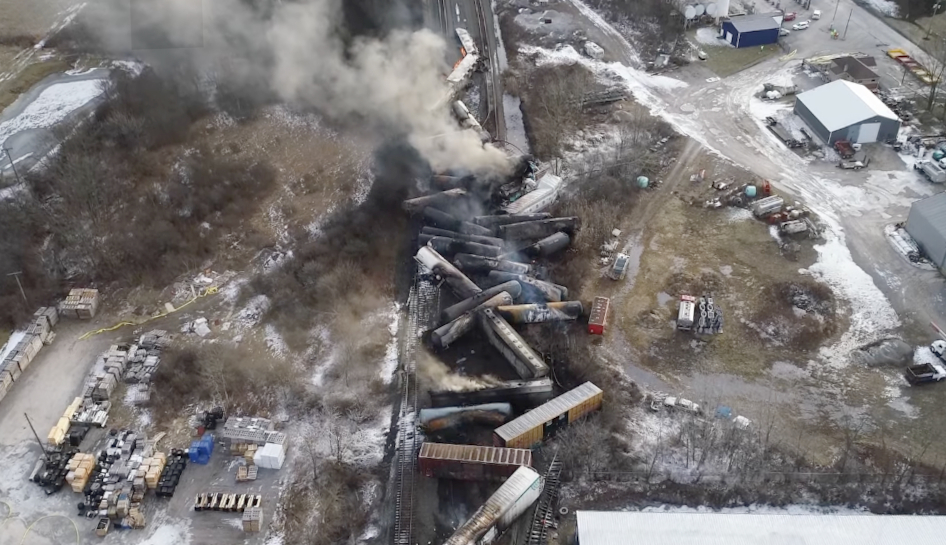Toxic Chemicals From Ohio Derailment: Months-Long Building Contamination

Table of Contents
The Toxic Cocktail: Identifying the Contaminants
The Ohio derailment released a dangerous cocktail of toxic chemicals, including vinyl chloride, butyl acrylate, and ethylene glycol monobutyl ether. These substances pose significant health risks through various exposure pathways.
-
Vinyl Chloride: A known carcinogen, vinyl chloride can cause liver damage, respiratory problems, and an increased risk of several types of cancer. Its persistence in porous building materials like wood is particularly concerning.
-
Butyl Acrylate: This chemical is an irritant that can affect the eyes, skin, and respiratory system. Inhalation can cause serious lung damage. Its persistence varies depending on the material it contaminates.
-
Ethylene Glycol Monobutyl Ether (EGMBE): Exposure to EGMBE can result in kidney and liver damage, central nervous system depression, and reproductive issues. Its solubility in water makes it a potential contaminant of building water systems.
These chemicals can contaminate buildings through various pathways:
- Airborne Contamination: Toxic fumes can penetrate building structures, leaving residues on surfaces and potentially in the air.
- Water Ingress: Contaminated water can seep into basements and foundations, contaminating building materials and potentially leaching into drinking water supplies.
- Direct Contact: Direct contact with contaminated soil or debris during cleanup efforts can lead to exposure.
The long-term health effects associated with exposure to these chemicals are a major concern, ranging from respiratory illnesses and skin irritation to cancer and reproductive problems.
Assessing the Extent of Building Contamination
Accurately assessing the extent of building contamination presents significant challenges. The lack of comprehensive testing and difficulties in accessing affected areas hinder a full understanding of the problem.
-
Testing Methodologies: Current testing methods include air sampling, water sampling, soil sampling, and material testing. However, the limitations of these methods include the cost, invasiveness, and potential for incomplete data. Sampling needs to cover a wide range of materials within the structures to account for the varied persistence of these chemicals.
-
Limitations of Current Testing: Existing tests may not detect all contaminants or accurately measure their concentration in all materials. Further, the long-term effects of low-level exposure to these chemicals are not fully understood.
-
Need for Long-Term Monitoring: Long-term monitoring and assessment are essential to track the persistence of contaminants and evaluate the effectiveness of cleanup efforts. This requires ongoing investment in resources and robust data collection.
The Impact on Community Health and Well-being
Residents of East Palestine and surrounding areas have reported a range of health issues since the derailment. While some are short-term effects, the potential for long-term consequences is deeply concerning.
-
Reported Illnesses: While comprehensive data is still being collected, reports include respiratory problems, headaches, skin rashes, and other symptoms consistent with exposure to toxic chemicals.
-
Psychological Impact: The psychological toll on the community should not be underestimated. The fear of long-term health effects, the disruption to daily life, and the uncertainty surrounding the future have profoundly affected residents' mental health.
-
Long-Term Healthcare Needs: The long-term healthcare needs of affected residents will require substantial resources, including specialized medical care, ongoing monitoring, and support services. Longitudinal studies are crucial to track the incidence of disease within this population.
Cleanup and Remediation Efforts: Challenges and Solutions
Cleanup and remediation efforts are ongoing, but face significant challenges.
-
Remediation Techniques: Techniques employed include decontamination of affected areas, removal of contaminated materials, and, in some cases, demolition of severely affected structures. The choice of method depends on the level and type of contamination.
-
Financial Burden: The financial burden of cleanup falls on individuals, the local government, and potentially the responsible parties. The sheer cost and complexity make this a monumental undertaking.
-
Long-Term Solutions: Long-term solutions must address the potential for future incidents and ensure the long-term health and safety of the community. This includes advanced warning systems, better regulation of hazardous materials transport, and robust environmental monitoring.
Legal and Regulatory Responses to the Ohio Derailment
The Ohio derailment has sparked numerous lawsuits against the railway company and other potentially responsible parties. The legal ramifications are complex and will unfold over time.
-
Lawsuits: Several lawsuits have been filed, seeking compensation for damages, injuries, and property losses. These lawsuits will likely address issues of negligence, liability, and the adequacy of safety regulations.
-
Regulatory Changes: The disaster has prompted calls for changes to regulations governing the transportation of hazardous materials. Improved safety protocols, stricter enforcement, and enhanced emergency response plans are all areas for potential improvement.
-
Effectiveness of Current Regulations: The Ohio derailment underscores the limitations of existing regulations and the need for a comprehensive review of safety standards and enforcement mechanisms.
Conclusion
The Ohio train derailment presents a significant and persistent threat of building contamination, posing serious long-term health risks to the affected communities. The full extent of the damage is still being uncovered, and ongoing comprehensive cleanup efforts are crucial to mitigate the consequences. Further research, transparent communication, adequate resources for testing and remediation, and robust legal accountability are vital to address this ongoing environmental disaster. The long-term health monitoring of residents must be a priority, alongside the development of preventative measures for future incidents.
Call to Action: Learn more about the ongoing impact of the toxic chemicals from the Ohio derailment and how you can support affected communities. Stay informed about the latest updates on building contamination and advocate for stronger regulations to prevent future environmental disasters caused by hazardous material transportation.

Featured Posts
-
 Sabrina Carpenter And Taylor Swift A Friendship Built On Boy Problems
May 06, 2025
Sabrina Carpenter And Taylor Swift A Friendship Built On Boy Problems
May 06, 2025 -
 Nike X Hyperice Collaboration Products And Release Date
May 06, 2025
Nike X Hyperice Collaboration Products And Release Date
May 06, 2025 -
 Riana Skritiyat Muzikalen Vdkhnovitel Na Ed Shiyrn
May 06, 2025
Riana Skritiyat Muzikalen Vdkhnovitel Na Ed Shiyrn
May 06, 2025 -
 April 2nd Nba Playoffs Celtics Vs Heat Game Time And Viewing Guide
May 06, 2025
April 2nd Nba Playoffs Celtics Vs Heat Game Time And Viewing Guide
May 06, 2025 -
 Is Miley Cyruss Relationship With Billy Ray Cyrus Over A Look At Recent Events
May 06, 2025
Is Miley Cyruss Relationship With Billy Ray Cyrus Over A Look At Recent Events
May 06, 2025
